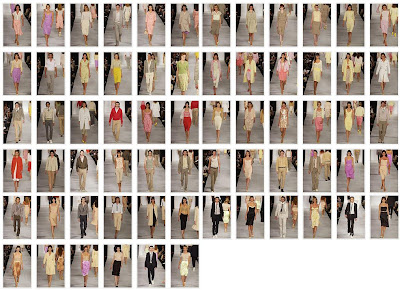











"We're ready, we're ready to start the show." That was Marc Jacobs himself, addressing the audience from the stage (stage, not runway) at 7:11 p.m. At 7:17, as Kevin Federline was still taking his seat in one of the makeshift, nightclub-style VIP booths not far from Selma Blair, Gretchen Mol, and Helena Christensen, Sonic Youth struck the first dissonant chord of "Jams Run Free," and Jacobs' first model walked out past the band. She wore a shawl-collar pouch-back coat in a shade that looked like camel, although we can't say for sure, concert lighting not being the best kind to illuminate such details. (One thing was immediately clear—whether he shows on a Friday or a Monday, it's always going to be an event.)The day switch and that revolutionary mere-17-minutes-behind-schedule start time weren't the only changes since last season. If Spring was all about sex, overt sex specifically, this show—his old friend Kim Gordon's gyrations notwithstanding—had a willfully sedate quality.Afterward, when asked about his inspirations, Jacobs replied, "I really wasn't very inspired this season. I just live my life." OK. When pressed, he offered a few more words: "Calm. Glamour. Casual. Beautiful women." Vague as that sounds, it was in fact an apt description for a collection that hinted at the eighties of Jacobs' early days in New York. It was there in the puffy headbands the models wore around their foreheads and the clubby atmosphere inside the Armory (some said it gave them Regine's, though the set's menacing scaffolding and the unsettling black-and-white images that played on a screen behind the band also suggested a more downtown environment). And it was there in the palette of soft pastels and grays and the relaxed (in terms of shape, not sensibility), somewhat masculine cut of the classic clothes.Jacobs showed plain-front button-downs with straight skirts; almost preppy popcorn-knit sweaters with narrow shorts; a cashmere sweater that spelled out HARDCORE paired with baggy leather pants; and a thigh-length bomber over a full, shin-grazing skirt. But his big focus was jackets and coats, many of which came with vertical folds of fabric gathered in the back above wide, hip-slung sashes. Dresses, too, came with pronounced volumes at the back. For evening, their stiff folds were replaced by gold or silver lamé pantsuits (paging Loulou de la Falaise) and drippy bias-cut velvet gowns.Was this collection, in its relative tameness and intriguing air of sexless safety, a rebuff of sorts to last season's detractors, who reprimanded Jacobs as much for his off-the-wall collection as for his perennial lateness? Could be. These clothes are challenging for different reasons than were the difficult transparent pieces he featured for Spring, but they'll be no less coveted. As for the show's accessories, women everywhere will have Jacobs to thank when other designers follow his lead and start producing a lower heel. That's the power of Jacobs' mystique.
 for this collection,
for this collection,grey,white,orange,blue
Triadic Color Scheme is used ,




























.jpg)
.jpg)














